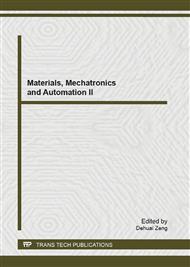p.86
p.92
p.99
p.105
p.112
p.120
p.128
p.134
p.140
Positioning and Path Planning for a Swarm Robotic Cleaner
Abstract:
The main purpose of this paper is to create an efficient ground-sweeping robot equipped with map-establishing and path-planning functions. Two ground-sweeping robots are connected with a master pc via a Blue-tooth protocol. The position of the ground-sweeping robot will be sent back to the master pc allowing the master pc to control the robots during the ground-sweeping process. An environmental map of the sweeping area will be established by emitting an ultrasonic wave from a rotating ultrasonic sensor within the robot. The geometry data will be sent back to the master pc via the Bluetooth module. The map of sweeping area will be made by the master pc using a wall-searching method. A single-chip Microcontroller PIC18F4520 is used as a control core to control the motor speed via the PWM in the robot. The clockwise and counter clockwise rotation of the motor will then be manipulated by a TA7279 IC. The robot is equipped with two ultrasonic modules used to detect the distance between the robot and the obstacle. This information will be sent back to the master pc via the Blue-tooth module. Consequently, results reveal that a prototype of the swarm robot system using two ground-sweeping robots and a master pc has positioning and mapping abilities.
Info:
Periodical:
Pages:
112-119
Citation:
Online since:
August 2013
Authors:
Keywords:
Price:
Сopyright:
© 2013 Trans Tech Publications Ltd. All Rights Reserved
Share:
Citation:


